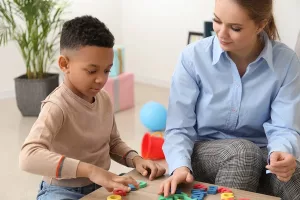Silence in speech therapy might seem ironic. How can you work on speech and language whilst NOT speaking? While modelling language and expanding on a child’s utterances are both vital to help them develop language, the benefits of being silent are often overlooked.
Silence in Therapy

When I started working as a Speech Pathologist, I found it hard to be silent with clients and their families. I had information to share, therapy to discuss, and language to model. I thought that if I could give the family as much information as I could, they would be armed with the knowledge to help improve their child’s speech or language concerns. Plus, staying silent in the session felt awkward and uncomfortable.
Over time, I have come to realise the importance of using silence in therapy. Silence can give families and clients time to process information. It can give them the opportunity to reflect on the session and the strategies used. It plays a fundamental role in developing a child’s speech and language skills, and can help clients feel respected, valued, and heard. Ultimately, silence is an essential tool in delivering client-centred therapy.
Here are some benefits of silence:
- Time for processing information
Therapy can be overwhelming for clients and their families. There are new terms to learn and new strategies to use, which can take time to understand. I use silence in the session to give the client or family a chance to process new information, questions, or instructions. Some individuals may need up to 20- or 30-seconds processing time. By pausing and being silent, we can give them the time and space they need to process and take away some of the pressure they feel to have an immediate answer.
- A chance for reflection
Silence can be used to help the client self-reflect. During the moments of silence in the session, clients have the opportunity to pause, slow down, review their work, and make any changes before I step in with feedback. This can foster their independence and develop their awareness of their own skills. This can be a vital part of therapy, as the client is able to see progress by reflecting on their own performance.
- Language development
When working on building a child’s language skills, they need to be engaged in the activity for it to be most effective. A great way to do this is to take a step back and follow the child’s lead. I will often show the child various toys or activities and wait for them to choose something that interests them. By taking that moment to step back and wait for the child, I am using silence to give them an opportunity to initiate some form of communication, such as a choice of activity, a request for assistance, an opportunity to communicate a ‘no, I don’t want/like that message’ or an invitation for me or someone else to join them in a shared interaction. From here, I can then model language and build on their language about the activity. This gives them language skills to talk about things that they are interested in, which they are more likely to remember and use in future.
- Client-centered focus
Using silence in therapy helps to maintain a client-centred focus. When gathering information from clients or their family members, I reduce my talking to give them time to speak and elaborate on their personal situation, concerns, and anything else they find important for therapy. This gives me a more holistic perspective about their situation and allows me to make a more informed decision when planning therapy for them. By using silence in my sessions, I am more likely to notice crucial details about my clients that can affect therapy.
- Reduce overload
Too much noise or chatter can be overwhelming, and clients may disengage or try to block out the noise. By pausing and talking less, I can help to reduce the cognitive and sensory load for my clients, which can help them to focus and engage in the session. Silence in this situation can also help the client to identify what is important. I may pause to signify meaning, build anticipation, and emphasise a new concept or word. This can help my clients to focus on the important information that we work on together.
Strategies to use at home
There are ways that you can use silence at home to help your child with their language skills.
- Follow your child’s lead
Give your child time to choose toys or activities that they are curious about. You can comment on the items that they have chosen and model the language about things that interest them.
- Give your child time to respond

Be patient with your child and give them time to respond to questions or instructions. They might need this time to understand what you want from them. Use gesture and pictures with your words to further support their understanding.
- Pause at the end of familiar phrases
For phrases that you use all the time with your child, try to pause before the end of the phrase to encourage your child to join in. This may be during routines, songs, or books which your child is familiar with.
- Take a step back and wait for your child
Rather than anticipating your child’s needs, try to take a step back and see if they can try to ask you themselves. They may try to look at you for help, pull on your arm, or initiate some form of communication with you.
- Reduce noise and distractions
Try to reduce any noises or other distractions which may affect your child’s attention. This can be less overwhelming and can support your child to focus on what you are saying or on what they are trying to tell you.
Ultimately, silence is an essential strategy to use in therapy, at home, and in the community. While it may seem ironic, silence really is a great way to help our children develop and improve their language skills. I urge you to try this with your child and see how they react. You might be surprised by the impact that it can have.
Get in touch
If you have any concerns or questions about your child’s speech or language skills, get in touch with Beam Health for a chat about your child’s situation and how we may be able to help.
References:
Fahim, D. (2019). Tips for Therapists and Teachers – The Sacred Sound of Silence. Education and Therapeutic Spaces LTD. https://doniafahim.com/tips-for-therapists-and-teachers-the-sacred-sound-of-silence/
Hartwell-Walker, M. (2017). The Importance of Therapist Silence. Psych Central. https://psychcentral.com/pro/the-importance-of-therapist-silence#1
Stephan, T. (n.d.). The Waiting Game: An Essential Skill for Parents of Children with Language Delay. Hanen.org. http://www.hanen.org/About-Us/Who-We-Help/Academia/Hanen-Insider/The-Waiting-Game-An-Essential-Skill-for-Parents-of.aspx?_cldee=YW5kcmVhbHlubjE3QGhvdG1haWwuY29t








